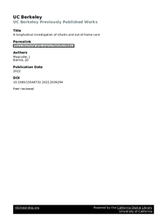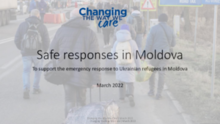Demographic Data
|
Sources: World Bank, UNDP, UNAIDS, DHS 2013 |
Displaying 1771 - 1780 of 14391
This resource was developed by SOS Children's Villages Belgium as an annex to the Practice Guidance. This tool provides guidance for social workers working with unaccompanied refugee and migrant children on how to use trauma-informed practices in a culturally sensitive way.
The Guidance Document was developed to support organisations taking part in the Organisational Development workshops for the project. Through the workshops, we aim to establish a trauma-informed culture in organisations that care for and support children and young adults in alternative care.
As part of the “Safe Places, Thriving Children” project, SOS Children’s Villages has developed a series of six e-learning modules which aim at increasing participants’ understanding of trauma and its effects on children and young people, and provide guidance on how to act in a more trauma-sensitive way when working with children, young people and families.
The Practice Guidance was developed by CELCIS and SOS Children’s Villages as a resource for participants taking part in the “Safe Places, Thriving Children” training. The purpose of this guidance is to improve understanding and practice in relation to working with children and young adults who live in alternative care settings and who may have experienced trauma.
This study offers a longitudinal examination of a population-based cohort of infants born in 2001 who entered care during the first year of life and who were followed through multiple care episodes until age 18. Findings suggest that using single, first episode data overstates the proportion of children who successfully reunify and understates the proportion of children who are adopted, return to care, or live with guardians.
Instruirea „Principii Sigure și Demne în Situații de Urgență” oferă spre discuție subiecte importante precum responsabilitatea noastră de a proteja copiii și adulții expuși riscului în situația de urgență actuală; principiile „de a nu face mai rău
The training Safe Responses During Emergency Situations covers topics such as our responsibility to protect children and adults at risk in an emergency, the principles of 'do no further harm’ and 'best interests of the child’ in practice; the four Rs: recognition; response; reporting; recording and what we can and should practically do in an emergency situation.
The U.N. refugee agency says more than 4 million refugees have fled Ukraine since Russian troops invaded the country
Children make up half of all refugees from the war in Ukraine, according to UNICEF and UNHCR. More than 1.1 million children have arrived in Poland, with hundreds of thousands also arriving in Romania, Moldova, Hungary Slovakia and the Czech Republic.
The United Nations Children’s Fund (UNICEF) said Wednesday that at least 2 million children have been forced to flee Ukraine amid the ongoing Russian invasion. UNICEF and the U.N. Office of the High Commissioner for Refugees (UNHR) said in a statement that children make up half of all refugees from the ongoing conflict that has continued for over a month.






